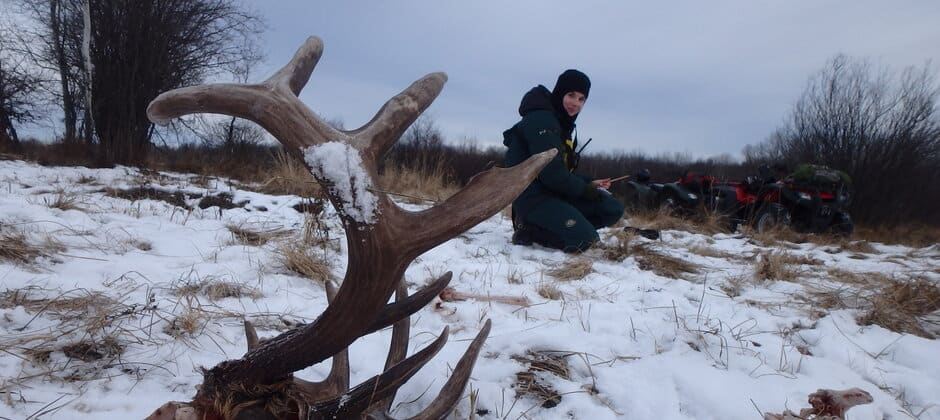Share this article
JWM: GPS collar data can help researchers track wolf kills
Courtney Irvine had just spent 30 minutes digging up clumps of bison hair at a wolf kill site in Prince Alberta National Park in Saskatchewan when she heard the howls. On a cold day in January 2016, Irvine, a park employee at the time, and a colleague rode a snowmobile for about half an hour, then walked another hour or so on snowshoes until they finally arrived.
The crew knew exactly where they were going. They were following GPS information sent out from collars secured on wolves in the park. The signals led them to suspect a wolf pack had made a kill.
Once the team arrived, they still had some difficulty ahead of them. The researchers avoid disturbance by waiting seven days for the wolves to move on before setting out to determine the prey species. But it had snowed during this waiting period.
“When wolves consume prey, it’s strewn about,” Irvine said, but this time it was also buried. Luckily for the researchers, gray wolf (Canis lupus) packs tend to beat down the underlying snow. “You often feel the kill site under your feet before you can recognize it,” she said.
The team dug around until they found clumps of hair and a skull that revealed the prey had been a young bison (Bison bison).
After recording the data of the kill site, Irvine and a colleague were on their way back to the snowmobile when they heard howls from a pack of about six wolves. They had conducted these types of kill site visits a number of times before, but this was the first time Irvine actually heard the pack they were following. “I was in awe of hearing these incredible predators—it’s not an experience that many people get to have,” said Irvine, who now works with Parks Canada at Pukaskwa National Park in northern Ontario.
The researchers were collecting this data to help them develop a method to determine information on wolf kills without having to verify dead prey in the field every time. As part of the study published recently in the Journal of Wildlife Management, they used information from collars placed on nine wolves from two packs between December 2013 and March 2017. They gathered location data between October and March for most of those years, receiving location data once per hour in those time frames.
Irvine, then a master’s student at Trent University in Ontario, and her colleagues ran this data through an algorithm that determined when wolves remained in one place for a period of time. Whenever they found those clusters of close activity, Irvine and her colleagues ventured out into the field to look for evidence that would tell them whether the area was a recent kill site or just somewhere the wolves rested for a period. In total, they snowmobiled and snowshoed out to thousands of kill sites over the study period.
During the study, wolves preyed on white-tailed deer (Odocoileus virginianus), bison, moose (Alces alces) and elk (Cervus canadensis). The researchers even found some cases of the wolves preying on black bears (Ursus americanus) and mule deer (Odocoileus hemionus). They found that wolves typically killed prey in early evening.
Their model was relatively successful at predicting kill sites based on GPS data. But it was a lot better at predicting when wolves took large prey like bison, elk and moose compared to white-tailed deer or smaller animals. That’s partly because the wolves take much longer to eat the larger prey compared to the smaller animals. “[A pack] can demolish a [white-tailed] deer in an hour or less,” Irvine said. White-tailed deer made up a large amount of the wolves’ diets.
The next step for researchers is to use the GPS collar information to better determine how many bison wolves are preying on in the national park. Bison are a priority for wildlife managers, and the data gathered in this study can help save money and time in tracking bison deaths from wolf predation, Irvine said. In addition, future research can focus on smaller prey. In the future, she said, if researchers used GPS collars that pinged data back more than once per hour, they might get more accurate data on tracking the kill sites of smaller prey.
This article features research that was published in a TWS peer-reviewed journal. Individual online access to all TWS journal articles is a benefit of membership. Join TWS now to read the latest in wildlife research.
Header Image: Irvine kneels by the remains of a white-tailed deer killed by wolves in Prince Albert National Park in Saskatchewan. Credit: Parks Canada








